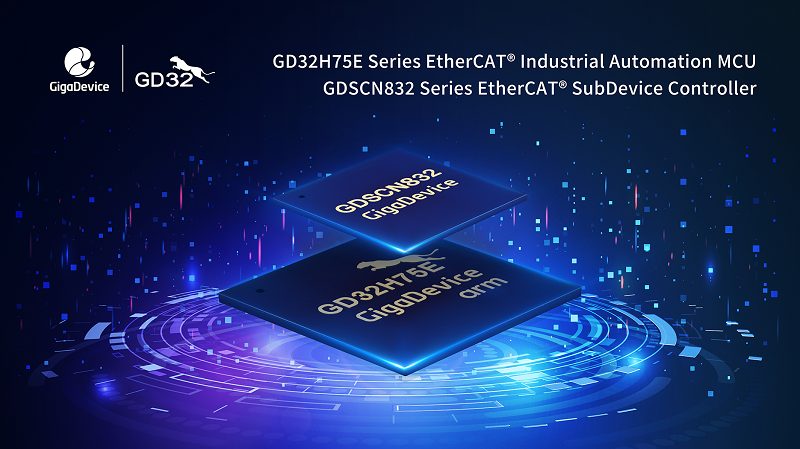Enabling High-Performance EtherCAT® Applications with GDSCN832 and GD32H75E
2025-10-11
Against the backdrop of the continuous pursuit of efficiency, intelligence, and connectivity in the field of industrial automation, GigaDevice has set a new industry benchmark with its portfolio of advanced chip solutions. To accelerate the application and development of EtherCAT® technology, GigaDevice has introduced two key products: the GDSCN832 series EtherCAT® SubDevice Controller and the ultra-high-performance GD32H75E series industrial automation MCU. By combining advanced control algorithms with optimal hardware technologies, these products significantly enhance real-time performance, flexibility, and cost efficiency, making them particularly suitable for robotics applications that demand stringent high-precision synchronization and multi-axis coordination. With high bandwidth and low latency communication features, they can be widely applied in motion control systems for industrial robots, collaborative robots, and automated production lines, providing a solid foundation for intelligent robotics and flexible manufacturing.
Leveraging these products, GigaDevice will further advance the integration of industrial automation and robotics technology, delivering richer and more efficient solutions to developers and enabling innovation and modernization of industrial control systems.

What Kind of MCU Does EtherCAT® Require?
Born in 2003, EtherCAT® (Ethernet for Control Automation Technology) is a high-performance Ethernet communication protocol designed specifically for industrial automation. By delivering high-speed and stable data transmission, it meets the requirements of servo control sytems for precise synchronization and rapid response. EtherCAT® supports microsecond-level distributed clock synchronization, ensuring high-precision multi-axis coordinated motion control. At the same time, its simple network topology and flexible configuration simplify installation and maintenance, while reducing CPU load so that more resources can be allocated to complex control algorithms.
In addition, EtherCAT® offers broad device compatibility and a robust ecosystem, with many manufacturers providing standard-compliant products such as servo drives and I/O modules. This ensures interoperability while allowing users to choose the most suitable hardware combination for their needs.
In the field of industrial robotics, EtherCAT®’s application is particularly prominent. Its microsecond-level response time and nanosecond-level synchronization accuracy are critical for multi-axis collaborative equipment such as six-axis robotic arms. Public information shows that leading robot manufacturers like KUKA and FANUC widely adopt EtherCAT® as a control bus to support complex tasks such as welding, handling, and painting. The current trend of humanoid robots requires the control of numerous joints and integration of multiple sensors, and EtherCAT®’s high bandwidth and multi-SubDevice management capabilities provide the necessary support. Its distributed clock mechanism achieves sub-microsecond synchronization across joints, ensuring smooth and natural motion.
For servo systems that support EtherCAT® protocol, choosing the right MCU as the control core is crucial. Such an MCU must first possess strong processing capabilities, for example, by adopting a high-performance CPU core such as ARM® Cortex®-M7, to manage real-time communication and execute complex servo control algorithms. Furthermore, the MCU should be equipped with sufficient RAM for data buffering and program execution, along with non-volatile memory for firmware and settings. High-resolution timers/counters are indispensable for precise position, speed, and torque control, while ADCs are required to sample feedback signals. The MCU must also support multiple peripheral interfaces to connect sensors and other components, and in some cases, RTOS support may be needed to ensure system stability and response speed. If the application involves safety requirements, the MCU should also provide fault detection, redundant pathways, and support for safety protocols.
Most importantly, the MCU should integrate or support external EtherCAT® IP to simplify design and improve performance. The core function of the ESC is to handle Ethernet frames during communication between the EtherCAT® Master and SubDevices, mapping data to local registers or memory to enable real-time, efficient data exchange. An MCU with integrated ESC reduces the need for external components, optimizes data paths, and further enhances system response speed and stability.
By these standards, GigaDevice’s GDSCN832 series EtherCAT® SubDevice Controller, officially licensed by Beckhoff, together with the ultra-high-performance GD32H75E series industrial automation MCU, are undoubtedly ideal choices for the control cores of modern servo systems.
Superior Configurations and High-Level Security Assurance
These two chips not only excel in ESC functionality but also surpass mainstream products in overall configuration. The GDSCN832 EtherCAT® SubDevice Controller integrates 2 internal PHYs and 1 MII expansion interface, with dual-channel integrated Ethernet physical layer devices. Each channel provides a full-duplex 100BASE-TX transceiver, supporting 100 Mbps operation. The series supports 8 Fieldbus Memory Management Units (FMMUs), boosting data processing performance and security, reducing memory access latency, and enhancing system response speed and real-time performance. It also offers 8 Sync Manager Entities for efficient memory management.
The product provides up to 8 KB of dual-port memory space, laying a solid foundation for big data processing in complex control systems. The built-in 64-bit distributed clock ensures high-precision time synchronization via synchronous and asynchronous SubDevice interfaces on the host bus, achieving accuracy better than 1 µs. Additionally, it supports 8-bit and 16-bit serial/parallel communication interfaces and is compatible with SPI, QSPI, and OSPI slave interfaces with communication speeds of up to 100 MHz. It also supports EXMC synchronous mode. This wide range of interface options offers users flexible configuration schemes to suit different application scenarios.
The GD32H75E series is built on a high-performance ARM® Cortex®-M7 core with an ultra-high frequency of up to 600 MHz, maintaining outstanding performance even with RAM ECC enabled. It supports up to 512 KB of TCM, greatly enhancing real-time processing capability. On-chip, it provides 1 MB SRAM, including 512 KB TCM and 512 KB shared SRAM, plus 1024 KB to 3840 KB of on-chip Flash, ensuring sufficient memory for data-intensive applications.
GD32H75E integrates EtherCAT® IP, embedding an ESC subsystem and a suite of high-performance peripherals such as 3x CAN-FD, 2x USB, High-Performance Digital Filter (HPDF), EDOUT, 14-bit ADC, 12-bit DAC, and comparators. By combining powerful MCU computing performance, ESC, PHY, large memory, safety features, and diverse peripherals, it effectively reduces PCB size, lowers cost, and decreases power consumption. This high level of integration is especially advantageous for compact servo controllers and robotics applications.
In industrial applications, safety is a critical concern, encompassing both functional safety and information security. GigaDevice’s GD32H7E series has passed TÜV Rheinland certification, and obtained IEC 61508 functional safety certification, providing a complete functional safety delivery package that includes all safety elements such as hardware, software, and documentation. The series is equipped with memory ECC, watchdog timers, supply voltage monitors, internal temperature sensors, and memory protection units. In addition, complete Self-Test Library (STL) software diagnostic solutions are available for CPU, SRAM, and Flash to detect potential hardware faults, ensuring system reliability and safety.
In terms of information security, product design needs to strike a balance between ensuring security and avoiding excessive protection, ensuring the effective implementation of key security functions while preventing unnecessary cost increases and reduced usability from overinvestment in advanced security measures. The GD32H75E incorporates code protection, secure boot, secure debugging, True Random Number Generator (TRNG), eFuse, hardware encryption engines, and security lifecycle management. These “application-fit” security features deliver strong protection while maintaining high cost-effectiveness.
By launching the GDSCN832 series and GD32H75E series simultaneously, GigaDevice not only provides a standalone EtherCAT® interface chip solution but also offers a high-performance MCU with integrated EtherCAT® IP. Compared with delivering only a single EtherCAT® interface chip, this strategy brings more options to customers and significantly improves flexibility.
Building Stronger Servo Motor Drives
Centered around the GD32H75E series, GigaDevice has developed a servo motor drive application solution. It adopts the standard CiA402 protocol and leverages TwinCAT for real-time control, making it widely applicable in robotics, CNC lathe machines, automated production lines, robotic arms, and other fields.
This solution incorporates multiple powerful features. In control, it supports Profile Position (PP) Mode, 30 types of Homing Modes (HM), and Cyclic Synchronous Position (CSP) Mode. Specifically, in Profile Position (PP) Mode, fixed-point trapezoidal curve planning ensures a smooth, error-free process, maintaining stability and precision even at high speeds. Together with homing and limit switches, it enables 30 homing modes, giving users the flexibility to choose the most suitable homing strategy based on application scenarios, thereby improving system adaptability and accuracy. The solution also features a built-in velocity observer for real-time velocity monitoring, enabling smooth and rapid response under varying loads, thereby enhancing the dynamic performance and stability of the system.
In signal sampling, the solution combines a Σ-Δ modulator with the HPDF module to achieve in-line current sampling. A Σ-Δ modulator is a signal processing technology that can improve the resolution and accuracy of current sampling, while the High-Performance Digital Filter (HPDF) optimizes signal quality. Together, they enable online, high-precision measurement of motor drive currents, contributing to more accurate motor control, reduced electromagnetic interference, and improved overall efficiency.
Overall, this solution integrates advanced control algorithms and technologies, with carefully designed functions to enhance overall performance, strengthen system stability, and ensure excellent performance even in complex industrial environments.



























































